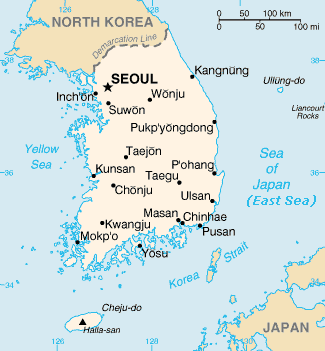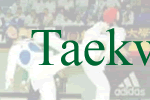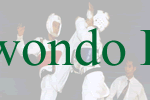![]()
Adult's
History Page
Basic Taekwondo Facts
- Taekwondo (Tae-Kwon-Do). The art of kicking and punching.
- Tae = Kick. Kwon = to strike with the hand. Do = The art.
- Taekwondo is known as a kicking martial art.
- Earliest record of Taekwondo dates back to 50 BC.
- Taekkyon (Taek-Kyon) is the earliest known form of Taekwondo.
Ancient Korean History
- Map showing where each kingdom is on the Korean peninsula. (See bottom of page for maps of ancient and modern Korea)
- Ancient Korea divided into three kingdoms: Silla (Sil-La)-founded 57 BC, Koguryo (Ko-Gore-Yo)-founded 37 BC, Baekche (Bak-Chay) -founded 18 BC.
- Evidence of Taekkyon found on Muyong-Chong (M-Young-Chong) ceiling - a royal tomb from Koguryo dynasty. Pictures there of men showing knife hand, fist and classical fighting stances.
- Taekkyon started in the Koguryo kingdom (Koguryo Dynasty - 37 BC to 668 AD).
- Silla kingdom constantly attacked by Japanese pirates. Silla kingdom asked for help from Koguryo. King Gwanggaeto, (G-Wan-Gay-A-Toe) 19th Koguryo king, sent 50,000 soldiers in 400 AD to help the Silla. Believed that Taekkyon was introduced to the Silla warrior class in secret by the Koguryo at that time.
- Taekkyon spread and grew under Silla's warrior class - the Hwarang (Wa-Rang). Their society was called the Hwarang-Do. "The Way of Flowering Manhood."
- Hwarang, or leaders - an elite group selected from sons of royalty, ages 16-20
- With the Hwarang were the Nando - cadets from rest of the young nobility.
- Total number for both was between 200 and 1000 at a time.
- Educated in History, Confucian philosophy, ethics, Buddhist morality, riding, archery, sword play, military tactics, and Taekkyon.
- Hwarang also skilled in poetry, singin, and dancing. They traveled throughout the country. They spread Taekkyon during the Silla dynasty.
- Taekkyon was a sport then.
They were guided by the Five Codes of Human Conduct
|
|
|
|
|
Today they have become the 11 Commandments of Modern Taekwondo
|
|
|
|
|
|
|
|
|
|
|
Korean Dynasties
- Koguryo Dynasty - 37 BC - 668 AD.
- Silla Dynasty - 57 BC - 936 AD.
- Koryo (Core-Yo) Dynasty - 935 - 1392. Taekkyon now called Subak (Sue-Bak) under King Uijong (U-E-Jong)(between 1147-1170) it became a fighting art.
- Yi(Chosan) Dynasty - 1397-1907. Book written on Subak. This led to spread of Subak to the general public and its survival. In late Yi Dynasty it became a sport again and was practiced in secret.
Overthrowing Japanese Rule
- In 1909 Japan occupied Korea. Lasted for 36 years.
- Japanese banned all martial arts in Korea. Led to secret rebirth of Subak - studied in Buddhist temples. Others studied Judo, Karate, and Kung-fu in Japan and China. Led to their introduction in Korea.
- 1945 Korea was liberated from Japan. Led to rebirth of Taekwondo in Korea.
Growth of the Art
- Kwans or schools spread a native style of martial arts.
- Kwans started in 1945 - Chung Do Kwan, Moo Duk Kwan, Yun Moo Kwan, all in Seoul
- Kwans started in 1946 - Chang Moo Kwan, Chi Do Kwan
- 1953 to early 1960's seven other Kwans founded. Most prominent were: Ji Do Kwan, Song Moo Kwan, and Oh Do Kwan (1953-54)
- All emphasized different aspects of Taekyon/Subak.
- Different styles evolved - Soo, Bahk Do, Kwon Bop, Kong Soo Do, Tae Soo Do, Dang Soo Do, and Taekkyon.
- In 1945 forms of Taekwondo grew strong in the Korean Military. 1946 - a master taught it to troops in Kwang Ju.
- 1952 - President Syngman Rhee watched a demonstration and ordered it be taught to all Korean military.
- A master was sent to Fort Benning, Georgia in 1952 and demonstrated to military and civillian audiences.
- During the Korean war (1950-1953) Korean martial artists formed special commando groups - most famous were the "Black Tigers." They fought across enemy lines and many died in battle includeing many Kwan founders.
- 1953, the 29th Infantry Division, on Che Ju Island became responsible for all Taekkyon training in the Korean Army.
- 1955, the Kwans met to unify under a common name - Tae Soo Do. In 1957 they changed it to Tae Kwon Do because it described the art more accurately and more resembeled Taekkyon.
- Some Kwans did not merge. Hopkido remained a recognized separate art. Some animosity remained between the Kwans.
- The Korean Tae Kwon Do Association was founded on September 14, 1961.
- In the 1960's many demonstrations of Taekwondo were given throughout the world leading to its establishment in many countries.
- The World Taekwondo Federation (WTF) was founded as the only official organization recognized by the Korean government on May 28, 1973.
- In the same year the first biennial championship was conducted in Seoul, Korea at the Kuk-Ki-Won (built in 1972 to train advanced students from around the world).
- Taekwondo's prominence in international sports brought it to the attention of GAISF - General Association of International Sports Federation, and association of all international sports, both Olympic and non-Olympic, with ties to the IOC - International Olyjmpic Committee. The WTF was admitted to the IOC in 1980. In 1988 Taekwondo was an official demonstration sport for the 1988 Olympic games in Seoul, Korea. In 2000 in Sydney, Australia, Taekwondo became a fully recognized sport.
STC History
- The Sacramento Taekwondo Club was founded in 1990 by Barbara Brand.
- Master Barbara Brand is also called Kwanjangnim which means Taekwondo master, 5th degree or above. She holds a 6th Degree Black Belt in Taekwondo and a 1st Degree Black Belt in Judo.
- As of June 2008, the club has had 54 promotional examinations.
- As of June 2008, Master Brand has awarded 41 Black Belts to students.
Books on Taekwondo History
"Modern
History of Taekwondo"
By Masters Won Sik Kand and Kyong Myong Lee.
Tells the story of the development of the separate Korean Kwans (schools)
and their elimination leading to the unification of Taekwondo in Korea.
(49 pages) Will require patience to read all the narrative discussions.
"History of Taekwondo"
A comprehensive review of Taekwondo
history from ancient times until the present. (79 pages) Something
of interest here for everyone. No author identified.>
"The State of the Art Taekwondo"
By Sung Chul Whant, Jun Chul Whang with Brandon
Saltz.
Broadway Books, New York, NY 1999
Chapter 1 contains an excellent general history of Taekwondo, pages 1-12.
Chapter 2 discusses Taekwondo philosophy and the Hwarang Code. It
also gives the Korean names for the 5 Principles.
NOTE: Steve Nahay has a copy of the section if you would like to borrow
it.





